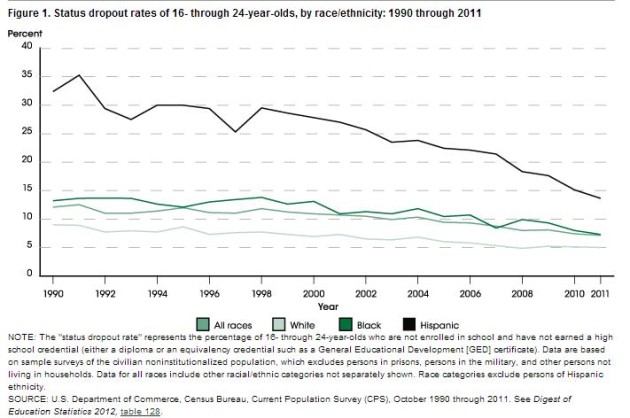I’m going to commit a little heresy today. Here it goes: High school dropout rates are not as bad as we think, even for students of color.
Yes, there are still wide gaps between whites and students of color when it comes to four-year graduation rates, especially in Minnesota. But there is no dropout crisis, here or in the United States.
Nationally, dropout rates are falling.
Here’s a national look at the numbers from the National Center for Education Statistics. The data show the percentage of 16- through 24-year-olds who are not enrolled in school and have not earned a high school or GED diploma.
The NCES writes:
The status dropout rates declined for low-income families (the bottom 25 percent of all family incomes) from 24 percent to 13 percent, middle-low income families from 15 percent to 9 percent, and middle-high income families from 9 percent to 5 percent.
Reflecting the overall decline in the status dropout rate between 1990 and 2011, the rates also declined for Whites (from 9 percent to 5 percent), Blacks (from 13 percent to 7 percent), and Hispanics (from 32 percent to 14 percent).
Look at the same data by race and gender and it’s even more eye-opening. The dropout rate for black females has fallen from 14 percent in 1991 to 6 percent in 2011.
In Minnesota, we worry a lot about gaps between whites and students of color, and we should. But there’s also a lot we don’t know. That’s true especially with graduation rates and dropout rates.
We focus on four-year graduation rates. But many students of color continue their education beyond four years. State education officials do not know what happened to a significant percentage of students of color who did not graduate. Here’s a look at four-year graduation data of Minnesota seniors in 2012 using data from the Minnesota Department of Education.
This is the “on time” data we typically see showing white kids outpacing other students in four-year graduation. But look at the students of color who haven’t graduated in four years but who aren’t counted as dropouts. There are many kids who either continued their education or are simply unaccounted for.
“Unknown” students are those who showed up in data as neither dropping out nor graduating from the group. They were expected to return for their senior year but were not reported.
Again, I’m not arguing that kids shouldn’t graduate on time. We shouldn’t have 18 percent of American Indian students dropping out after four years of high school. But what happened to the 36 percent listed continuing or unknown?
But before we call it a graduation crisis, maybe it’s time to step back and ask: What happened to all those “unknown” kids? What if it takes a couple extra years for “continuing” students to graduate high school or earn a GED?


